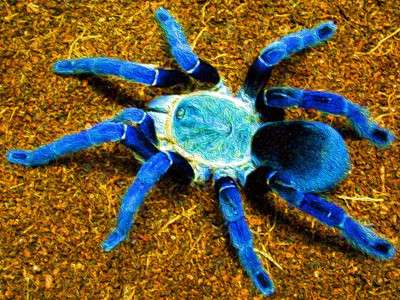
The peacock tarantula, commonly known as Poecilotheria metallica, is an Old World species of spider. The only blue species in the Poecilotheria genus is this one. It displays an interesting fractal-like pattern on the abdomen, just like other members of its genus. In Andhra Pradesh, in central southern India, a deciduous forest serves as the species’ natural habitat. The IUCN has given it the status of Critically endangered.
The hue of gooty sapphire tarantulas is a bright blue. They are a well-liked tarantula in the pet sector due to their distinctive coloring. These intriguing tarantulas, which are native to Gooty, India, are also known as metallic blue tarantulas
Physical Appearance
- These medium-sized tarantulas have bright blue hairs all over them, even on their legs. They contain two body segments, the head of which is slightly smaller than the abdomen section.
- Their knee joints seem yellow, and they have lengthy segmented legs. Right after a molt, the color is stronger, giving the blue bristly hairs an iridescent appearance.
- The males are a little bit smaller than the females, who as adults can have a leg span of 6 to 8 inches. Compared to other tarantulas, their bodies are more oblong and have longer legs. That’s a huge spider whose legs would hang off the edges if it were stretched out on your cell phone!
- Pedipalps are an additional set of appendages that they have in addition to their eight legs. These serve as feelers and aid in pinning down prey. When mating, the males make use of them.
Habitat
Only a limited portion of southeast India is home to the Gooty Sapphire tarantula. They are situated in a reserve forest fewer than 40 square miles in size (less than 100 square kilometers). This region can be compared to a monsoon forest with two extremely dry seasons separated by extremely wet seasons (nearly continual rain). Gooey sapphires are able to cope with either extreme. The weather is typically warm and muggy.
Although they begin their lives as small spiderlings on the ground, as adults they become arboreal and live in holes in trees. Both during the wet and dry seasons, they spend the most of their time up in the branches and along the trunks. They are fantastic climbers and capable of incredible vertical climbs.

Food
The primary predators of Gooty Sapphire tarantulas include larger spiders, birds, and arboreal snakes.
Reproduction
Unlike New World tarantulas, male Gooty Sapphires lack tibial hooks, but they nevertheless accomplish their goals. Like New World tarantulas, they are susceptible to being devoured by their female mate, and they do pass away soon after mating. A sperm web is formed, and the sperm is then transferred to the receptive female by a similar technique.
Each year, female Gooty Sapphire tarantulas lay between 40 and 50 eggs, which are then wrapped to form an egg sac. The spiderlings begin their existence as terrestrial, living on the ground, and gradually make the switch to arboreal life in the treetops as they grow older.
Lifespan
The gender of a Gooty Sapphire tarantula affects how long it lives. Males live closer to 4 years on average compared to females’ average lifespan of about 12 years.
Table





